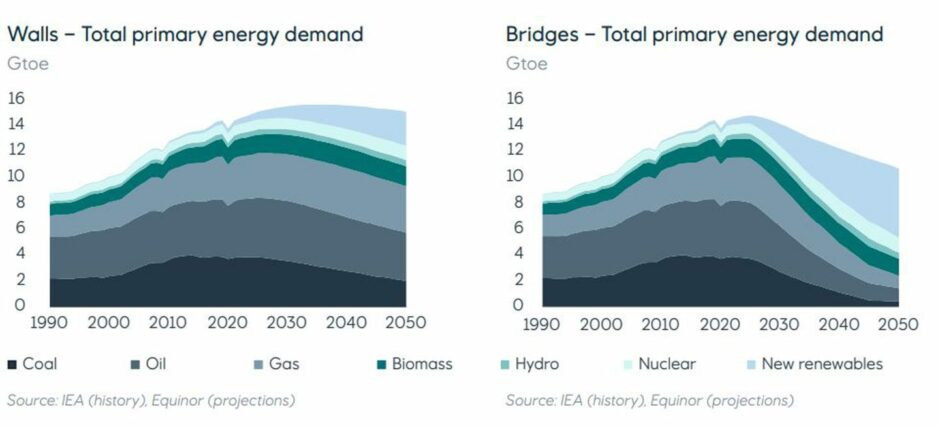
A new report from Equinor analysts presents two potential pathways for energy transition, and warns of the gap between incremental change and rapid decarbonisation needed to meet Paris goals.
In its new Energy Perspectives report, Equinor warned of the “common misperception” that achieving net zero will deliver on the 1.5°C target to limit global warming as set out by the Paris Agreement.
The report presents two distinct scenarios for the global economy, international energy markets and energy-related emissions, dubbed “walls” and “bridges”.
“Walls” shows the likely pathway if the world continues to follow the current trends of decarbonisation, whilst “bridges” illustrates a pathway that not only achieves net zero by 2050, but also complies with the required carbon budget.
These share near-identical paths up until 2025, at which point they start to diverge. However, Equinor says the latter scenario must see changes implemented at an “astonishing rate” – driven by strong policy support throughout – to achieve “radical and unprecedented reduction in emissions” if the target is to be met.
Analysts also warned that meeting Paris Agreement goals would be tougher than fulfilling net zero.
“[The 1.5C] target requires cumulative net carbon emissions to remain under a finite level, whilst net zero requires only that emissions are balanced by an equivalent amount of carbon removal after some specific point in the future,” the analysts note.
The Paris-compliant goal is therefore far harder to achieve than a simple balancing of net-zero emissions, and Equinor warns that “of the many pathways that lead to net zero by mid-century, the vast majority will not meet the 1.5°C target.”
Indeed, in the “walls” pathway, the 1.5°C emissions budget is already exhausted by 2032.
“Walls divide and bridges connect. Our new scenarios paint a large outcome space for what the long-term energy future might look like based on choices made today and going forward,” explained the group’s chief economist, Eirik Wærness.
“Russia’s invasion of Ukraine earlier this year has not only tragically impacted the lives and livelihoods of those directly affected, but the associated geopolitical tensions have also further deteriorated global cooperation, trade and supply flows on which a sustainable energy transition is completely dependent,” added Mr Wærness.
And with energy now “weaponised” as a result of Russian aggression, the report notes that energy security will now be a key policy priority for all governments attempting to navigate the so-called energy trilemma – and finds “little to suggest a return to normalcy any time soon.”
Energy trends
Each pathway sees differing peaks for fossil fuel demand. In “walls” the peak occurs in 2026, followed by a gentle downward trajectory, while in “bridges” demand falls away rapidly beyond 2025 and by 2050 all remaining use is either fully abated or compensated by carbon removal.
Within that, “walls” sees growing gas demand with a peak in 2041 around 10% higher than today’s demand levels, while “bridges” sees a peak in 2025, before rapidly tailing off to around one quarter of today’s level in 2050.
Meanwhile wind and solar PV continue to surpass all previous trends in both scenarios. In “walls”, wind capacity is six times greater, and solar PV capacity 12 times greater in 2050 compared with today.
In “Bridges”, wind capacity is 12 times greater, and solar PV capacity 27 times greater in 2050 compared with today.
In both scenarios, the share of electricity in consumption grows, reaching 50% in the slower pathway and well above in the accelerated “bridges” pathway.
Hydrogen too will grow in both pathways, though under current trends will only accelerate in the early 2030s as large new projects are developed in parallel with infrastructure.
In “bridges”, the share of hydrogen in the energy mix rapidly increases, reaching 9.8% of in 2050, driven by the need to replace the remaining emissions from gas power generation.
Looking to longer-term trends, Equinor analysts also pointed to challenges in other energy sectors, such as refining, where companies must battle to deal with keep costs low amid increasing demands for renewable feedstocks.
“In these testing times, we must stay focused on the longer-term transformative measures and structural changes needed for a sustainable energy future. Reaching the goals of the Paris Agreement is an immense challenge and will require continuous engagement, collaboration and commitment from governments, industries, investors, and consumers alike,” added Equinor president and CEO Anders Opedal.
Recommended for you

 © Supplied by Equinor Energy Persp
© Supplied by Equinor Energy Persp